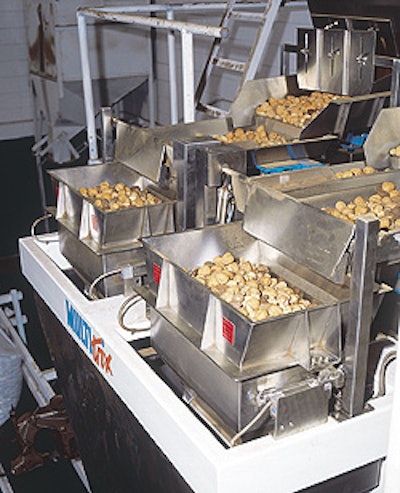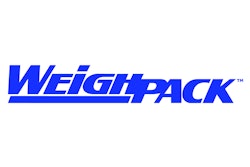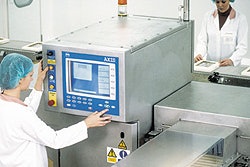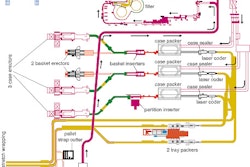
Before this summer, operators at Diamond of California’s Robertsdale, AL, plant manually filled bulk quantities of in-shell nuts into bags and boxes. The process was not only labor-intensive but created excessive product giveaway. With the July addition of a microprocessor-controlled, triple-pan weighing system, the plant has
• reduced giveaway by 50%;
• increased filling speeds of 50-lb bags to 450/hr from 250/hr;
• saved 1% in labor costs during each nine-month growing season; and
• realized savings in forklift rental costs.
“Before, we had two people manually filling bags [or boxes] while one person sewed bags shut,” recalls Bo Feely, Robertsdale’s plant superintendent. “When we filled manually with the older scale we were using, we would overfill bags, and we had a lot of giveaway and lost time,” he notes.
Looking to improve the situation, the plant sent its maintenance supervisor, Mike Pintarelli, to Diamond’s Chicago manufacturing facility. “We thought maybe Mike could bring back some ideas to make our packaging process more efficient,” says Feely. “At the same time last November, Pack Expo was running.”
Pintarelli continues the story, saying, “I saw a lot of equipment at the show, and picked up some literature. When I got back to Robertsdale, we checked into a bulk weighing machine that looked like it would be the best machine for us,” says Pintarelli. Specifically, the machine is an AEF-25 TW TP twin-head, triple-pan scale system from WeighPack Systems (Montreal, Quebec, Canada).
Triple-pan configuration
“The system has individual transfer, bulk, and dribble pans,” Pintarelli says. “So it fills two scales at once for added speed, but dumps product from one. So we fill one bag at a time, and by the time we get the next bag in place, the scale is ready to make the next product dump.”
At the 63ꯠ-sq’ three-building facility in Robertsdale, packing begins after processing of Brazil nuts and pecans, and following the receipt of finished almonds, walnuts, and hazelnuts. All nuts are packed in the shell. The AEF-25 is used for 3- and 5-lb mesh bags, 50-lb woven polypropylene bags, and 65-, 75-, 85-, and 90-lb bulk corrugated boxes. Materials are provided by various suppliers.
Product is conveyed on a vibratory conveyor that feeds into a bucket elevator, carrying nuts to an approximately 40’-long conveyor at a mezzanine level that accommodates the WeighPack scales, or separately, an older vertical form/fill/seal machine.
For the bulk containers, product is gravity-fed into a stainless-steel hopper. Beneath the hopper are two side-by-side transfer pans. Under both transfer pans are a bulk pan and a dribble pan. From these pans, nuts descend onto a scale hopper. Each hopper is equipped with a load cell. Each scale accommodates up to 50 lb of product, providing accuracy of ±1 oz on that size, Pintarelli estimates.
Accuracy comes from the scale’s Multi-Trix microprocessor that operates machine functions, including weight set points for both the vibratory bulk and dribble feed pans. The system also provides a control panel where Robertsdale operators can make adjustments for different nut varieties and packaging weights. Currently, the plant uses about 13 different recipes.
“We pull up a menu on the screen, select the product we want to run, and hit enter,” Pintarelli explains. “So we can do a changeover in a minute or two.” The only other necessary changeover task is to switch the filling funnel beneath the scale when a more elaborate size change is needed, such as going from a 50# bag to a 3# mesh bag. Even that only takes minutes, requiring an adjustment of three “thumb wheels,” as Pintarelli describes them. No tools are necessary to do the job.
When the desired product weight is reached, the scale releases product through the funnel or chute. For boxed goods, nuts fall into the open white corrugated case on a roller conveyor. For bags, the operator holds the bag open under the funnel to accept the fill. The bag is held just inches off the moving belted conveyor. The bag is filled in a matter of seconds and descends the few inches onto the conveyor.
The fill level is at least 6” below the top of the bag. That prevents product spillage as the bag conveys downstream to a high-speed sewing machine that applies the string closure.
Pintarelli says that a more automated method for this process is being developed. “We could have used clamps to attach the bag to the funnel, but the process was too time-consuming,” he says.
Pallet loads of nuts are shipped to retail grocery stores and mass merchandisers who fill nuts into bulk display bins for sale to consumers.
Two-season payback
Although the scale has only been used for a few months, it’s already earned the respect of Feely and Pintarelli at the Robertsdale plant. “The line runs on an as-needed basis,” explains Feely. “We used to be able to do about 250 50-pound bags an hour, and now we’re at 450 bags per hour. And we only need one person to fill rather than two.”
Again, using the high-volume 50-lb bags as a point of reference, Feely says that by using the WeighPack scale system, “we save at least four ounces of product per bag.”
Overall, the company estimates it’s reduced product giveaway by 50% on its various-sized packages.
Besides giveaway and labor savings, Diamond of California earns payback from savings on forklift rentals. Pintarelli explains, “We had packaged in two rooms before. By adding this scale, we could move our bulk bag and box packaging into the same room, so we only need one forklift instead of two. That’s about $1ꯠ a month in savings.”
Diamond of California would not divulge specific dollar savings. However, the combined labor, giveaway, and rental savings are justifying Robertsdale’s investment in the scale. “At this rate, we’ll pay off the machine in less than 18 months, or about two seasons,” Pintarelli estimates. And what about using the scale at other Diamond plants?
Pintarelli and Feely give the scale two thumbs up. “As far as I know, we’re the only plant using it right now,” Feely believes. “It’s pretty simple, and it works well. We’ve had no maintenance issues with it, and by automating filling, we’ve doubled our production speed on our 90-pound boxes.”





















